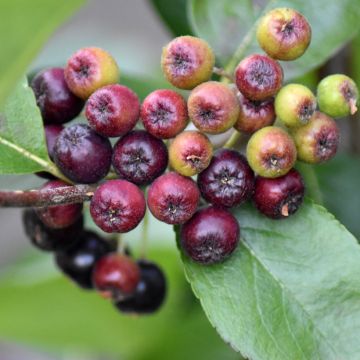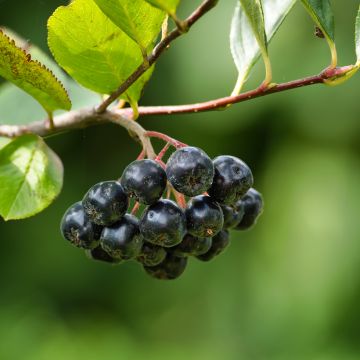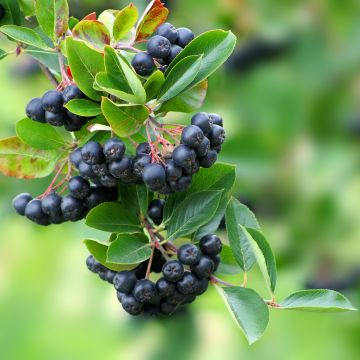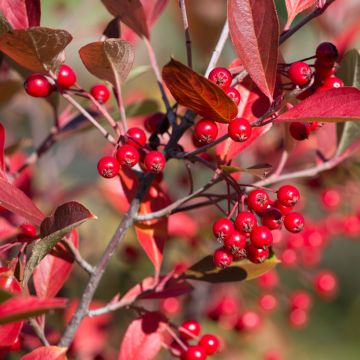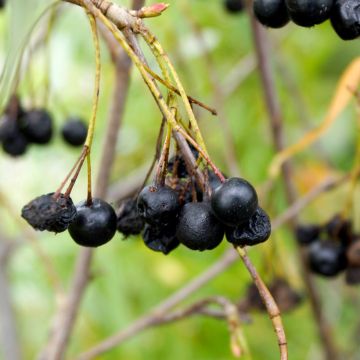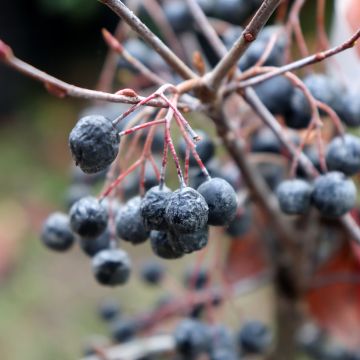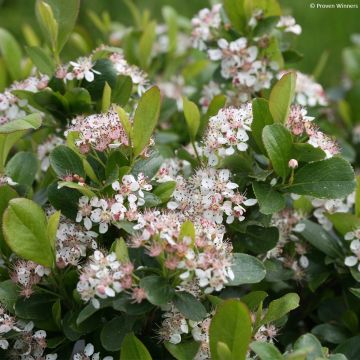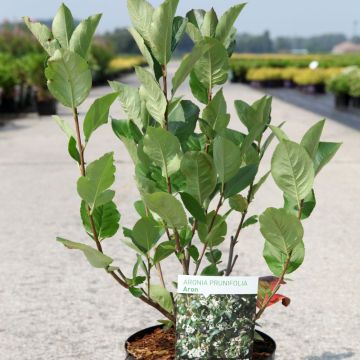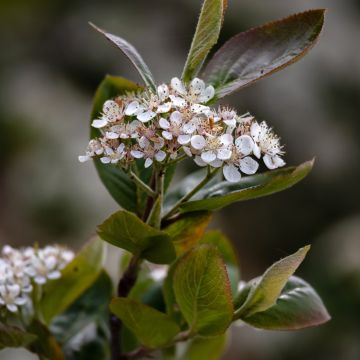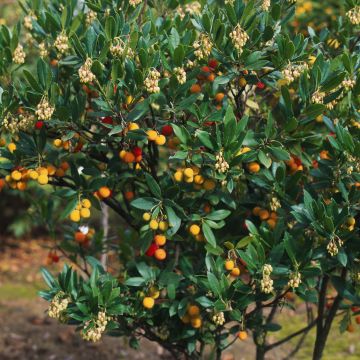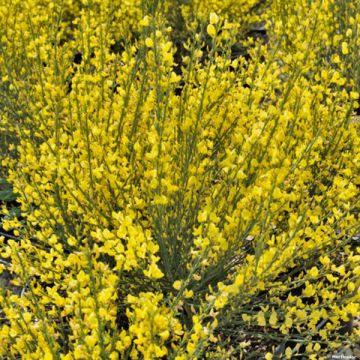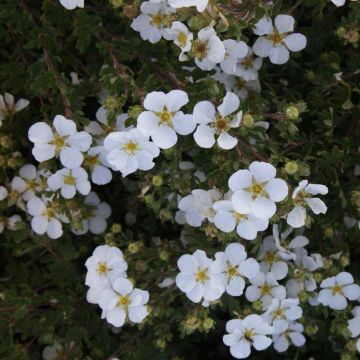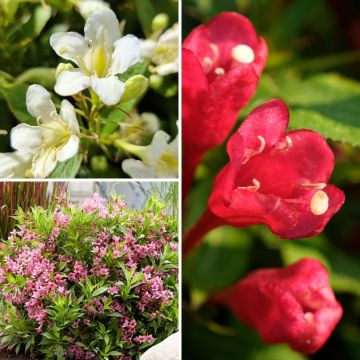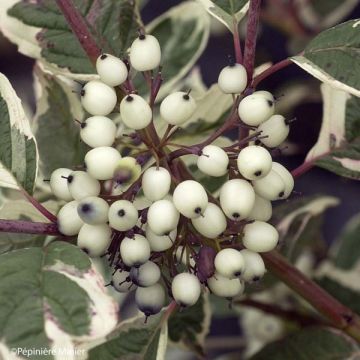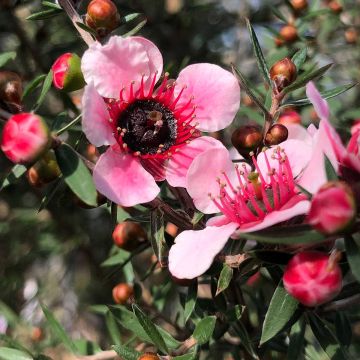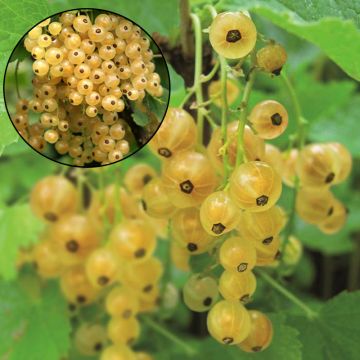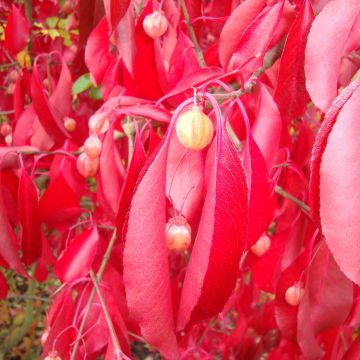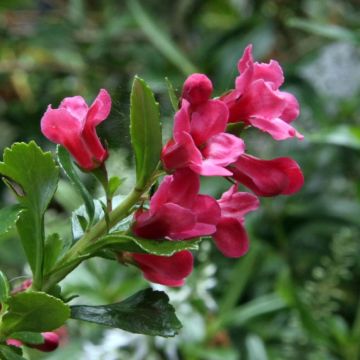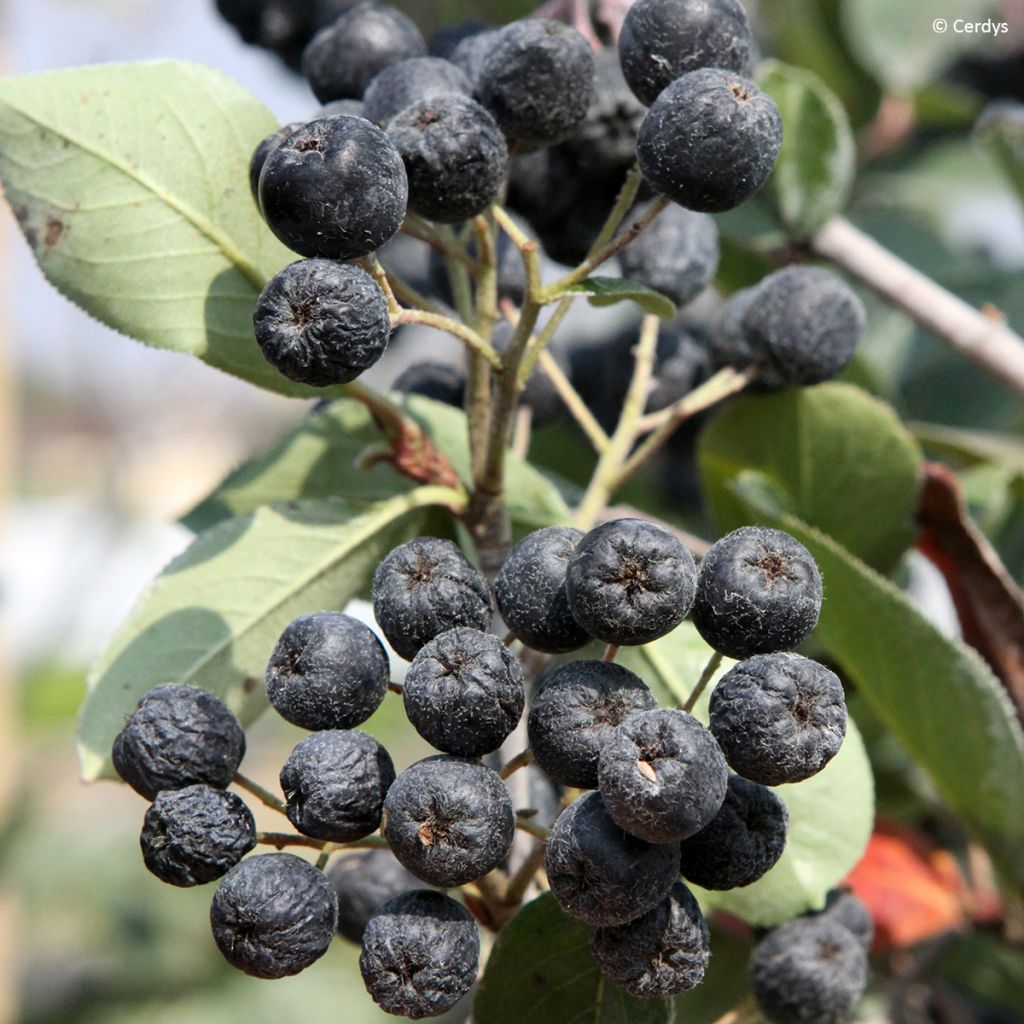

Aronia prunifolia Rubina
Aronia prunifolia Rubina
Aronia x prunifolia
Purple Chokeberry, Black Chokeberry
This item cannot be shipped to the selected country
Delivery charge from €5.90
More information
Schedule delivery date,
and select date in basket
This plant carries a 6 months recovery warranty
More information
We guarantee the quality of our plants for a full growing cycle, and will replace at our expense any plant that fails to recover under normal climatic and planting conditions.
From €5.90 for pickup delivery and €6.90 for home delivery
Express home delivery from €8.90.
Description
The Aronia prunifolia 'Rubina' is a hybrid variety of the prune-leaved aronia, a cross between the Aronia prunifolia 'Viking' and a Russian aronia berry. This bush, whose "super-fruits" are highly consumed in Asia, bears clusters of high nutritional value, resembling large blueberries or blackcurrants, which are harvested when ripe in September-October. Slightly astringent when fresh, they can make delicious jellies, pastries, fruit syrups, or jams. Its foliage is highly decorative, changing from green to purple, red, and yellow in autumn. Its spring flowers are white and melliferous. Very hardy, it can be grown in full sun or partial shade in deep, moist soil, preferably non-chalky.
'Rubina' is a distant cousin of roses, plum trees, and blackberries, a member of the vast rose family. Native to Canada and the northeastern United States, aronia plants are highly cold-resistant and thrive in cool, slightly acidic soils. They are now extensively planted in Eastern European countries to meet the demand of the Asian market.
'Rubina' forms a sparsely branched, open-growing bush reaching approximately 2m in height and 1.25m in width, sometimes more depending on growing conditions. It exhibits slow growth in its early years. Its bark is smooth and reddish-brown. It bears alternate, simple, ovate, finely toothed leaves measuring 4 to 5cm in length, with a glossy dark green colour that blazes in autumn, adopting various shades of orange, copper, crimson red, and violet. In April-May, it produces white flowers dotted with pale pink, measuring 2cm in diameter. Gathered in corymbs, there are numerous, highly fragrant, and melliferous. They give way to clusters of round fruits, measuring 1.5cm in diameter, initially green-purple and becoming blackish-purple and shiny as they ripen, while the peduncles turn red. This fruiting, slightly acidic, juicy, and rich in antioxidants, persists throughout winter if not consumed by birds. 'Rubina' is a self-fertile variety: a single plant is sufficient for a bountiful harvest.
Naturally resistant to diseases and pests, Aronia is an excellent bush, both hardy, ornamental, and undemanding. While it can tolerate poor soils, it will thrive best in non-chalky, cool, deep, slightly acidic soil. It can be planted individually in a free, countryside, hedgerow hedge, or large shrub borders. To achieve a spectacular mass effect, plant it in groups of 3 to 6 plants of the same variety. This 'Rubina' aronia pairs well in a hedge that is both beautiful and edible with other small fruit bushes, foliage or flowering, such as apple trees, ornamental plum and cherry trees, male cornel, hedge honeysuckle, serviceberries, Goumi, anemone trees, May berries, sea buckthorn, Goji, and blueberries. A perfect combination for creating vitamin-packed cocktails for the whole family!
The Aronia fruits can be consumed fresh, cooked, in jams, or as juice, which can be mixed, for example, with cranberry juice and apple juice. Chinese pharmacopoeia attributes medicinal properties and beneficial health effects to the berries of this Aronia fruit variety. The richness in polyphenols, especially anthocyanins, B and C vitamins (3 times more than oranges), minerals, and fibres make the Aronia berry one of the most nutritionally attractive small fruits.
Report an error about the product description
Plant habit
Fruit
Flowering
Foliage
Botanical data
Aronia
x prunifolia
Rosaceae
Purple Chokeberry, Black Chokeberry
Cultivar or hybrid
Other Aronia
Planting and care
The Aronia prunifolia Rubina is preferably planted in good, fertile, non-chalky garden soil in early autumn. While it is relatively tolerant, it prefers deep, moist to wet, light and slightly acidic soils. Plant it in a sunny, non-burning, or semi-shaded location. The colours are dull in the shade, and the fruiting is less abundant and flavourful. The hardiness of this bush is excellent, even in wet soil. Mulch and water wells are needed to help it establish, especially in the first summers. Remove excess suckers that hinder fruiting. Prune the oldest branches at the end of winter. It is naturally resistant to diseases and parasites but can sometimes be susceptible to rust.
Planting period
Intended location
Care
This item has not been reviewed yet - be the first to leave a review about it.
Hedge shrubs
Haven't found what you were looking for?
Hardiness is the lowest winter temperature a plant can endure without suffering serious damage or even dying. However, hardiness is affected by location (a sheltered area, such as a patio), protection (winter cover) and soil type (hardiness is improved by well-drained soil).

Photo Sharing Terms & Conditions
In order to encourage gardeners to interact and share their experiences, Promesse de fleurs offers various media enabling content to be uploaded onto its Site - in particular via the ‘Photo sharing’ module.
The User agrees to refrain from:
- Posting any content that is illegal, prejudicial, insulting, racist, inciteful to hatred, revisionist, contrary to public decency, that infringes on privacy or on the privacy rights of third parties, in particular the publicity rights of persons and goods, intellectual property rights, or the right to privacy.
- Submitting content on behalf of a third party;
- Impersonate the identity of a third party and/or publish any personal information about a third party;
In general, the User undertakes to refrain from any unethical behaviour.
All Content (in particular text, comments, files, images, photos, videos, creative works, etc.), which may be subject to property or intellectual property rights, image or other private rights, shall remain the property of the User, subject to the limited rights granted by the terms of the licence granted by Promesse de fleurs as stated below. Users are at liberty to publish or not to publish such Content on the Site, notably via the ‘Photo Sharing’ facility, and accept that this Content shall be made public and freely accessible, notably on the Internet.
Users further acknowledge, undertake to have ,and guarantee that they hold all necessary rights and permissions to publish such material on the Site, in particular with regard to the legislation in force pertaining to any privacy, property, intellectual property, image, or contractual rights, or rights of any other nature. By publishing such Content on the Site, Users acknowledge accepting full liability as publishers of the Content within the meaning of the law, and grant Promesse de fleurs, free of charge, an inclusive, worldwide licence for the said Content for the entire duration of its publication, including all reproduction, representation, up/downloading, displaying, performing, transmission, and storage rights.
Users also grant permission for their name to be linked to the Content and accept that this link may not always be made available.
By engaging in posting material, Users consent to their Content becoming automatically accessible on the Internet, in particular on other sites and/or blogs and/or web pages of the Promesse de fleurs site, including in particular social pages and the Promesse de fleurs catalogue.
Users may secure the removal of entrusted content free of charge by issuing a simple request via our contact form.
The flowering period indicated on our website applies to countries and regions located in USDA zone 8 (France, the United Kingdom, Ireland, the Netherlands, etc.)
It will vary according to where you live:
- In zones 9 to 10 (Italy, Spain, Greece, etc.), flowering will occur about 2 to 4 weeks earlier.
- In zones 6 to 7 (Germany, Poland, Slovenia, and lower mountainous regions), flowering will be delayed by 2 to 3 weeks.
- In zone 5 (Central Europe, Scandinavia), blooming will be delayed by 3 to 5 weeks.
In temperate climates, pruning of spring-flowering shrubs (forsythia, spireas, etc.) should be done just after flowering.
Pruning of summer-flowering shrubs (Indian Lilac, Perovskia, etc.) can be done in winter or spring.
In cold regions as well as with frost-sensitive plants, avoid pruning too early when severe frosts may still occur.
The planting period indicated on our website applies to countries and regions located in USDA zone 8 (France, United Kingdom, Ireland, Netherlands).
It will vary according to where you live:
- In Mediterranean zones (Marseille, Madrid, Milan, etc.), autumn and winter are the best planting periods.
- In continental zones (Strasbourg, Munich, Vienna, etc.), delay planting by 2 to 3 weeks in spring and bring it forward by 2 to 4 weeks in autumn.
- In mountainous regions (the Alps, Pyrenees, Carpathians, etc.), it is best to plant in late spring (May-June) or late summer (August-September).
The harvesting period indicated on our website applies to countries and regions in USDA zone 8 (France, England, Ireland, the Netherlands).
In colder areas (Scandinavia, Poland, Austria...) fruit and vegetable harvests are likely to be delayed by 3-4 weeks.
In warmer areas (Italy, Spain, Greece, etc.), harvesting will probably take place earlier, depending on weather conditions.
The sowing periods indicated on our website apply to countries and regions within USDA Zone 8 (France, UK, Ireland, Netherlands).
In colder areas (Scandinavia, Poland, Austria...), delay any outdoor sowing by 3-4 weeks, or sow under glass.
In warmer climes (Italy, Spain, Greece, etc.), bring outdoor sowing forward by a few weeks.

































